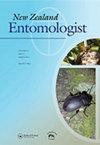Nelson核果园粉蚧及其寄生蜂的最新记录
IF 0.6
4区 农林科学
Q4 ENTOMOLOGY
引用次数: 3
摘要
摘要2008年至2011年间,在新西兰纳尔逊的果园里,从收获的苹果中采集的粉蚧中,大多数(65%–94%)是长棘假球菌。其余的(35%-6%)是黄杨,尽管偶尔也会发现一些小豆。2011年,在果园中部署了以最新开发的蒲团藻合成信息素为诱饵的诱捕器,吸引了粉蚧寄生蜂Alamella mira的雌性。2012年和2013年秋季,通过在发芽的土豆上部署哨兵粉蚧,对纳尔逊苹果园的粉蚧寄生复合体进行了为期8周的评估。马铃薯受到长棘假单胞菌(2012年和2013年)和黄绿假单胞菌的侵扰(仅2012年)。它们被部署在果园里捕捉在诱捕期间活跃的寄生蜂。哨兵粉蚧感染的土豆被放置在果园的三角洲陷阱中约2周,然后被取回并在奥克兰的实验室中保存4-6周。收集了寄生蜂的木乃伊,并对新出现的成虫进行了物种鉴定。2012年,在莫图埃卡附近的三个果园中发现了四个物种(四角目游隼、短角锥虫、古尔尼锥虫和江铃蛇)。2013年,三个物种(T.peregrina、C.gurneyi和Gyranusoidideadvena)被发现。监测方法似乎对回收的寄生蜂复合体产生了影响。多种监测方法的结合,包括粉蚧寄生蜂对宿主信息素的可能的kairomonal反应,以及从自然感染粉蚧的水果和树叶中饲养寄生蜂,可以对果园中粉蚧寄生虫的多样性和丰度进行最佳评估。本文章由计算机程序翻译,如有差异,请以英文原文为准。
Recent records of mealybugs and their parasitoids in Nelson pipfruit orchards
ABSTRACT The majority (65%–94%) of mealybugs collected from harvested apples in Nelson, New Zealand, orchards between 2008 and 2011 were Pseudococcus longispinus. The remainder (35%–6%) were P. calceolariae, although a few P. viburni were occasionally found. Traps baited with newly developed synthetic pheromone of P. calceolariae were deployed in orchards in 2011 and attracted females of the mealybug parasitoid Alamella mira. The mealybug parasitoid complex in Nelson apple orchards was assessed over an 8-week period in autumn during 2012 and 2013 by deploying sentinel mealybugs on sprouting potatoes. Potatoes were infested with P. longispinus (in 2012 and 2013) and P. calceolariae (2012 only). They were deployed in orchards to capture parasitoids that were active during the trapping period. The sentinel mealybug-infested potatoes were placed in delta traps in the orchards for about 2 weeks and then retrieved and held in a laboratory in Auckland for 4–6 weeks. Parasitoid mummies were collected and emerging adults identified to species. In 2012, four species (Tetracnemoidea peregrina, T. brevicornis, Coccophagus gurneyi and Ophelosia charlesi) were recovered from three orchards near Motueka. In 2013, three species (T. peregrina, C. gurneyi and Gyranusoidea advena) were recovered. Monitoring methods appeared to influence the complex of parasitoids recovered. A combination of monitoring methods, including possible kairomonal responses of mealybug parasitoids to host pheromones and rearing parasitoids from fruit and foliage naturally infested with mealybugs, may provide the best assessment of mealybug parasitoid diversity and abundance in orchards.
求助全文
通过发布文献求助,成功后即可免费获取论文全文。
去求助
来源期刊

New Zealand Entomologist
ENTOMOLOGY-
CiteScore
0.70
自引率
33.30%
发文量
3
审稿时长
>12 weeks
期刊介绍:
The invertebrate diversity of New Zealand is of great interest worldwide because of its geographic isolation and geological history. The New Zealand Entomologist plays an important role in disseminating information on field-based, experimental, and theoretical research.
The New Zealand Entomologist publishes original research papers, review papers and short communications. We welcome submissions in all aspects of science regarding insects and arthropods in a New Zealand or Australasian setting. The journal’s subject matter encompasses taxonomy, phylogenetics, biogeography, biological control and pest management, conservation, ecology and natural history.
The journal is the official publication of the Entomological Society of New Zealand. Papers published or submitted elsewhere for publication will not be considered, but publication of an abstract or summary elsewhere (e.g. conference proceedings) does not preclude full publication in the New Zealand Entomologist. Accepted papers become copyright of the Entomological Society of New Zealand. The journal is published in English, but we also welcome publication of abstracts in Maori.
 求助内容:
求助内容: 应助结果提醒方式:
应助结果提醒方式:


